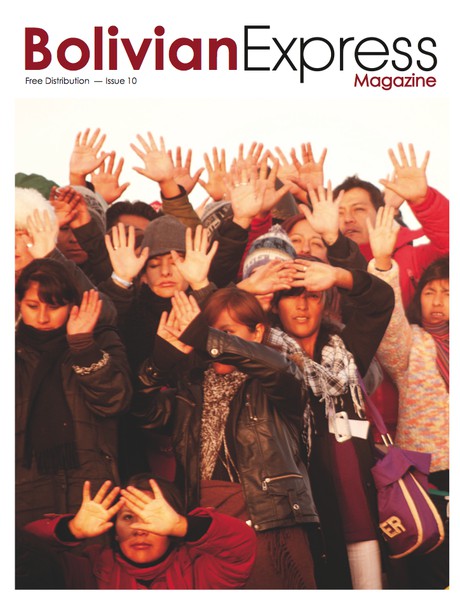
Just three hours after getting back from a our first experience at the nightclub ‘Traffic’, and with the taste of last night’s anticucho (a kebab of cow’s heart and potatoes sold on the street) still rather too prominent in my mouth, I woke up to keep to my arrangement to go to Mercado Rodriguéz with Sharoll to buy ingredients for a Bolivian feast that conveniently coincided with the national celebration of independence on 6th August.
Even with my Bolivian rosette and alpaca jumper, I think people could probably still tell I wasn’t a local. Trailing in Sharoll’s wake I had to navigate my way through row after row of fruit and veg I’d never seen before, the occasional cow’s tongue or testicle hanging at eye level and every third person babbling away in Spanish and asking to carry my bags for a tip. This was Borough Market on speed, and minus the food standards inspectors. Instead of the latex gloves and hair nets we bumped into a woman hacking at a cow’s head with an axe on a wooden stump.
We bought so many ingredients we needed to take a taxi back (after having stopped for some well-earned salteñas, of course), including a chicken complete with head and claws, and some black potatoes as we made our first dent into Bolivia’s 300 varieties2.
After about three hours in a kitchen somewhat too small to cook four dishes for twelve people, we huddled round a table big enough for six at a push. Silence descended as we started to work our way through sopa de maní (a peanut-based soup), plato paceño (a mixture of boiled vegetables with cheese), sajta de pollo (a spicy chicken dish) and timphu paceño (with lamb and rice), all flavoured with spicy locotos. It was great fun and Sharoll is a fantastic cook. I’m certainly a convert to Bolivian cuisine.
We have enough leftovers to last us the rest of the month. And it turns out .sopa de mani can be quite a good hangover cure. The black potatoes on the other hand tasted a lot like they looked – in a word, earthy.
We spent this weekend in Copacobana by Lake Titicaca. Those of us without dehabilitating hangovers left on Friday morning to arrive in time for lunch. Worryingly, when we asked about our hostel in the tourist offices (the immediate impression of Copacobana is that it is far more touristy than La Paz), no one seemed to have heard of it. After an hour’s searching, we finally found our hostel about 1km out of town down the beach. We were led through a building site to the only room ready for visitors. Apart from the occasional electric shock while adjusting the cold showers and the pack of dogs barking incessantly through the night, we were relatively comfortable.
We climbed the hill on the edge of the beach to watch the sunset with a couple of bottles of Bolivian wine. The view was stunning, and the wine… interesting. After an equally interesting descent down the mountain in deteriorating light, we bought more wine, and several bottles later, found ourselves stumbling down a jetty on the lake.
Despite splashing out for the 24 Bs (£2.40) bottles as opposed to the 17 Bs ones, roles were reversed on Saturday morning on the boat ride to Isla del Sol, as those who were hung-over on Friday offered as little sympathy to us as we had to them. Isla del Sol was also beautiful. The Incas believed it was the origin of civilisation, and without meaning to sound too gap yar, it did feel like a pretty special place. Dumped on the north side of the island, we had to trek 12kms to the other side to be picked up by the boat three hours later. In spite of hangovers and food-poisoning, it was a very enjoyable trip.
On Sunday, I experience possibly the most surreal experience of my life. We had rushed back from Lake Titicaca to witness the phenomenon that is ‘Cholita Wrestling’ in El Alto. I had no idea what to expect…
Once we got over the cringe-worthily feigned nature of it all (WWF fooled me for years, but I picked up on the fact that this wasn’t real slightly quicker), we were treated to cholita-on-cholita fights, a man dressed in as a skeleton fighting a cholita and Spiderman versus a werewolf. But my personal favourite has to have been a midget and a clown fighting a hairy man from Chile with a biased referee!

 Download
Download





















